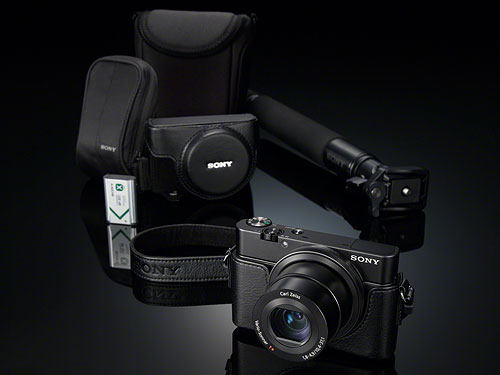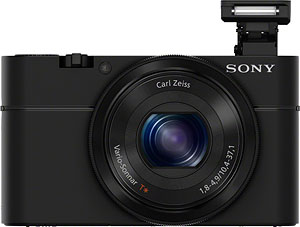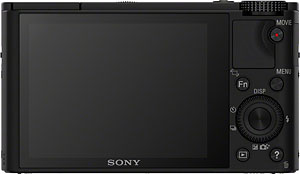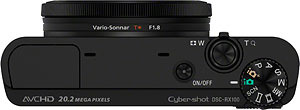Great things in small packages: The Sony RX100, reviewed!
posted Wednesday, June 6, 2012 at 12:00 AM EDT
 As confirmed camera addicts, we've been waiting years for anybody to make a large-sensor, compact camera with a fixed zoom lens. No sooner have we reviewed the first-such camera, Canon's PowerShot G1 X, than Sony has offered up a rebuttal with its own large sensor zoom compact: the Sony RX100.
As confirmed camera addicts, we've been waiting years for anybody to make a large-sensor, compact camera with a fixed zoom lens. No sooner have we reviewed the first-such camera, Canon's PowerShot G1 X, than Sony has offered up a rebuttal with its own large sensor zoom compact: the Sony RX100.
Barely any larger than the small-sensor Canon S100, the Sony Cyber-shot DSC-RX100 is similar in concept, but it couldn't be more different in implementation. Where Canon created a new image sensor with near APS-C height (but a 4:3 aspect ratio), Sony has gone back to the drawing board and designed a smaller one-inch sensor similar in size to that used by Nikon's 1-series compact system cameras. Yes, the sensor's smaller than that of the G1 X, but make no mistake--it is still much bigger than those typically found even in premium compacts. It's also a lot higher resolution, offering a whopping 20.2 megapixels.
Sony has placed the sensor behind a lens that's significantly brighter than the one in the G1 X, which helps even the playing field in terms of noise performance despite the disparity in sensor size between the two cameras. The Carl Zeiss Vario-Sonnar T*-branded lens has a 3.6x optical zoom range from a 28mm-equivalent wide angle to a 100mm telephoto, and starts from a bright f/1.8. This falls to around f/4.9 near the telephoto position, but across the range, it remains brighter than the Canon's lens. It also focuses much closer, for more useful macro performance: just 1.9 inches at wide angle, or 21.6 inches at telephoto.
|
Alongside the Sony Cyber-shot RX100, the company has introduced several accessories including a handsome, retro leather case and neckstrap. Photo provided by Sony. |
The Sony is also night-and-day different in size. The G1 X was styled much like earlier G-series PowerShots, but its bulk has a tendency to surprise when first you handle it. It's certainly smaller than an SLR or compact system camera with equivalent lens, but it's not a camera you'll slip in anything but a coat pocket.
By contrast, the Sony RX100 is not just pocketable, it's shirt-pocketable. This is a large-sensor camera you can take absolutely anywhere, and almost forget you're carrying it, until you need it. For an SLR or system camera owner who wants a more portable backup, that's hugely important. It also provides a nice alternative to anybody wanting a step-up camera without a step up in size.
That's not to say it's game over for the G1 X. To be sure, there are plenty of areas in which it offers a noticeable advantage. If you absolutely must have an optical viewfinder, for example, you'll need to look to the Canon. The Canon is also unique in offering a tilt-swivel LCD panel, where the RX100 has a fixed-position panel, albeit a WhiteMagic type with four dots per pixel. (The extra dot is a white one, used to increase brightness outdoors, and reduce backlight power consumption indoors.) The RX100 also lacks support for external flash strobes. And of course, there are advantages to the larger sensor in the Canon.
|
One picture, a thousand words: Pocketable body. Big sensor. Bright lens. Bionz processor. Rendering provided by Sony. |
It's interesting to see just how much the two cameras differ, in spite of the similar initial design concept. Each has managed to carve out its own niche, and each excites for different reason. If--like us--you're thrilled by the possibilities of the Sony RX100 as a compact step-up or a sibling to your interchangeable lens camera, then waste no time: read our Sony RX100 review! (And if you absolutely need the extra photographer-friendly features found on the Canon, read our G1 X review.)
The Sony Cyber-shot DSC-RX100 goes on sale in the US market from July 2012. Pricing is set at around US$650, and Sony has already announced a few accessories, including a handsome two-part leather case with neck strap for about US$85, and a screen protector for the LCD display priced at about US$12.
Now, really, take our word for it. Stop reading this, and go read our Sony RX100 review, instead! ;-)
(102 x 58 x 36 mm)
1-inch type (approx. 0.62 in. diagonal)
20.90 megapixels (total)
20.20 megapixels (effective)
4864 x 3648 (17.7 megapixels)
5472 x 3080 (16.9 megapixels)
3648 x 3648 (13.3 megapixels)
3888 x 2592 (10.1 megapixels)
3648 x 2736 (10.0 megapixels)
3648 x 2056 (7.5 megapixels)
2736 x 1824 (5.0 megapixels)
2592 x 1944 (5.0 megapixels)
2720 x 1528 (4.2 megapixels)
12416 x 1856 (23.0 megapixels)
8192 x 1856 (15.2 megapixels)
2160 x 5536 (12.0 megapixels)
2160 x 3872 (8.4 megapixels)
28 - 100mm (35mm equivalent)
Has AF assist lamp
Manual focus possible
Press Release
Sony’s New Advanced Cyber-shot RX100 Camera Packs Large Sensor and Bright Lens into Stylish, Pocket-Size Body
New Model Contains World’s First 1.0-inch type 20.2 MP Exmor CMOS Sensor and Ultra-bright F1.8 Carl Zeiss Vario Sonnar T* Fixed Lens to Deliver Outstanding Picture Quality
SAN DIEGO, May 16, 2012 – Travelling light no longer means compromising on picture quality with the Cyber-shot® DSC-RX100 camera, Sony’s new flagship compact camera.
Striking the ultimate balance of form and function, the stylish, aluminium-built RX100 camera inherits many advanced imaging features from Sony’s α range of A-mount and E-mount cameras, delivering beautiful still images, crisp full HD videos and a level of manual control and creativity unmatched by any other camera of its size.
“This camera is ideal for travel, portraits or street photography, delivering impressive results in a variety of lighting conditions with an intuitive, customizable control interface,” said Yosuke Tomoda, director of the Cyber-shot business at Sony Electronics. “It’s a perfect step-up model for point and shoot users not interested in larger DSLR or compact system cameras, and also an outstanding choice for enthusiasts who may already own a large DSLR and are looking for a high-quality, pocket-sized ‘all-in-one’ second camera.”
At the heart of the Cyber-shot RX100 is the world’s first 1.0-inch type Exmor® CMOS sensor with a resolution of 20.2 effective megapixels. Specially developed by Sony, the sensor has an area that’s approximately four times larger than the 1/2.3-type sensors in traditional point-and-shoot cameras. The sensor’s larger area takes in more light while capturing content, resulting in beautiful, detail-packed images and Full HD movie clips with very low noise.
The larger sensor is partnered with an exceptionally bright Carl Zeiss® Vario-Sonnar T* fixed lens with 3.6x optical zoom range. In contrast to standard point-and-shoot cameras, it has a wide F1.8 maximum aperture to let in additional light and complement the resolving power of the larger sensor.
Similar to high-performance DSLR optics, the lens features seven- bladed circular aperture. This makes it easy to produce images with subjects in sharp focus against a smoothly-blurred, beautifully defocused background. The lens also features an Advanced Aspherical (AA) lens element that contributes to the camera’s extremely compact dimensions without sacrificing optical zoom performance or resolution.
Newly optimized to complement the 1.0-inch type sensor and lens, the camera’s powerful BIONZ® image processor maximizes shooting response times while helping assure exceptionally clean, natural images. It also extends sensitivity right up to ISO 25600 (using Multi Frame Noise Reduction), allowing for exceptionally clear handheld images in low light conditions. To capture fast-moving subjects, the RX100 camera can also shoot at up to 10 frames per second (in full resolution) and has high-speed autofocus that locks onto a subject in as quickly as 0.13 seconds (depends on scene and lighting conditions).
The new RX100 camera features a high-resolution 3-inch 1,229k dot Xtra Fine LCD™ display and also adds a new feature: WhiteMagic™ technology. This uses additional white pixels to boost screen brightness, allowing users to see subtle details and tones on the screen in all types of shooting environments, including outdoors in bright sunlight.
For making manual adjustments while shooting both still images and movies, the new camera has a smooth control ring around the lens body, which can be used to alter exposure, zoom, creative picture effects and a variety of other customizable functions. Additionally, frequently used functions can be assigned to the Fn (function) button for instant access, and the Memory Recall feature can store up to three groups of customized shooting settings based on user preference.
Similar to a DSLR-style interface, there’s a choice of auto and manual focus modes on the Cyber-shot RX100 camera for enhanced image control. For those that prefer focusing manually, MF Assist magnifies images to simplify fine adjustments, and there’s also a pro-style peaking function that highlights sharply-focused areas of the image on screen.
The RX100 camera offers a generous choice of artistic options to expand creative shooting possibilities. It includes the option for six different creative styles and a variety of popular picture effects including Toy Camera, Partial Color, HDR Painting and several others, most of which can be previewed directly on screen before shooting.
The new Cyber-shot features Auto Portrait Framing – a feature found on Sony’s latest α range of A-mount and E-mount cameras -- making it simple to create sharp, perfectly framed portraits. This unique feature automatically detects faces in a scene, crops the picture accordingly creates a tighter, pro-style composition at full resolution. Both the original and cropped photo are saved for review.
New accessories include a spare battery, dedicated carrying case and a battery charger designed to complement to the new camera.
Pricing and Availability
The Cyber-shot DSC-RX100 digital camera will be available this July for about $650. The camera and accessories will be available at Sony retail stores (www.store.sony.com) and other authorized dealers nationwide.
###




